|
|
|
|
|
|
|
Achi-Kochi Japan
Showing many places to visit and foods to eat in Japan
|
|
|
|
|
|
|
|
|
|
|
|
|
Japan
> Kinki region
> Osaka City
|
|
|
|
|
|
|
Osaka City
Kinki ( Achi-Kochi Japan )
|
|
|
|
|
|
|
|
|
|
|
|
|
( "Achi-Kochi" in Japanese means "Here and there" in English. )
Osaka City
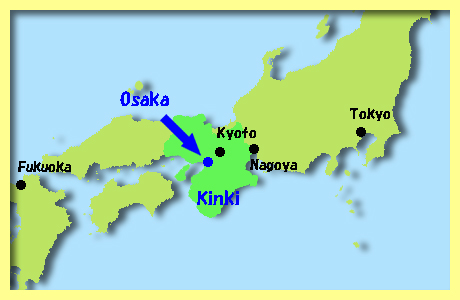
Osaka ( above ) is the third largest city whose population is nearly three million, the capital city of Osaka Prefecture and the center of the second largest metropolitan area in Japan where almost 20 million people live.
Also Osaka City is rich in history. In the 4-6th centuries, Osaka developed as an important international port. In the 7-8th centuries, the Imperial Palaces were located in Osaka ( ==> A History of Japan vol.1 Formation of Japan ). In the 16th century, the largest castle in Japan at the time was built in Osaka.
|
|
Main Keep of Osaka-jo Castle
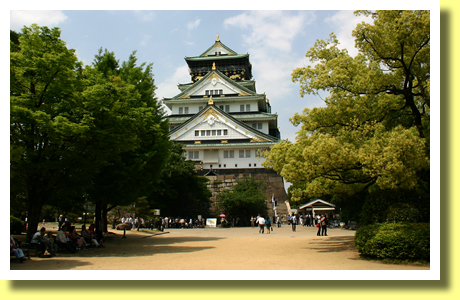
In A.D.1583, Hideyoshi Toyotomi started the construction of Osaka-jo Castle, which was completed in A.D.1585. At the time Osaka-jo was the largest among many castles in Japan. In A.D.1590, Hojo clan surrendered their Odawara-jo Castle to Hideyoshi, who unified Japan and ended the Sengoku Jidai ( Age of Warring States ==> A History of Japan vol.2 Samurai Age ). Osaka became the center of Japan. ( The above photo shows the main keep of the castle rebuilt in A.D.1931. )
|
|
Moats, Stone Walls and Turrets

When Hideyoshi died in A.D.1598, his son and successor Hideyori was five years old. In A.D.1600, Ieyasu Tokugawa won the Battle of Sekigahara, which made him the practical ruler of Japan. In A.D.1603, Ieyasu established Tokugawa Shogunate in Edo ( Tokyo now ). However Hideyori Toyotomi remained in Osaka-jo Castle defended by moats, stone walls and turrets ( above ) as well as rich war chest and many samurai warriors.
To nip off the bud of anxiety, Ieyasu attacked Osaka-jo Castle in A.D.1614 and in A.D.1615 when the castle was destroyed and the Toyotomi lineage was terminated. Osaka-jo Castle was reconstrcuted in 1620s by a son of Ieyasu, Hidetada Tokugawa ( who built Nikko Toshogu ). However the main keep was burnt down by a lightning in A.D.1665. The main keep was rebuilt with reinforced concrete in A.D.1931.
|
|
Osaka Museum of History

It is recommended to enter the Osaka Museum of History, from the top floor of which tourists could overlook Osaka-jo Castle as above. In the museum there are several scale models showing the history of Osaka.
|
|
Naniwa Palace

In the 7th century and again in the 8th century, Osaka ( "Naniwa" at the time ) had been the capital city of Japan, where Naniwa Palace was built. In Osaka Museum of History, tourists could see how people lived in Naniwa Palace as above. Also in the museum exhibited are lots of excavated articles relating to Osaka, including some designated National Important Cultural Properties of Japan.
|
|
Hanami ( Sakura Viewing )

Tourists, staying in Osaka in the season of Hanami ( Sakura Viewing ), could visit Japan Mint, which is located near Osaka-jo Castle and which is famous for Sakura ( cherry blossoms ). Just through a week in the season of Hanami, a part of Japan Mint is open to the public so that they could enjoy Sakura Viewing ( above ).
|
|
Doton-bori and Sennichi-mae
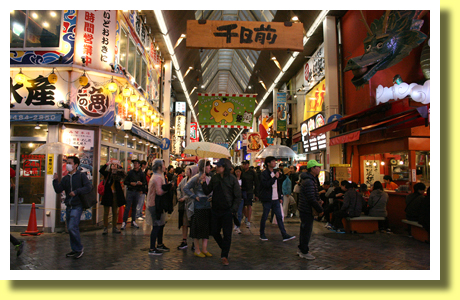
Doton-bori and Sennichi-mae ( above ) near Namba and Shinsai-bashi is an area so popular among local people and tourists who enjoy shopping and eating in the area. There are so many restaurants which offer Kuidaore dishes such as Tako-yaki and Okonomi-yaki.
|
|
Hozenji and Mizukake-Fudo
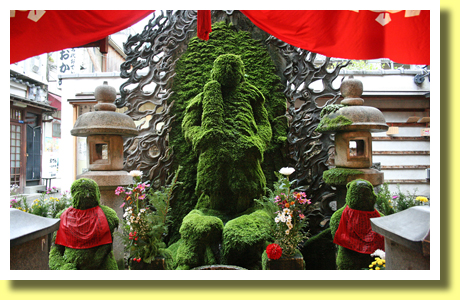
Around Doton-bori and Sennichi-mae, there are many back streets, one of which is Hozenji Yokocho, along which there are small restaurants which serve traditional local dishes. In Hozenji, people pour water over the statue of Fudo Myoo called "Mizukake-Fudo" ( above ) for fortune. "Mizukake" in Japanese means "pouring water". It made the statue moss-covered.
|
|
Tako-yaki

Not only in Doton-bori and Sennichi-mae area but also Achi-Kochi ( here and there ) in Osaka, Tako-yaki are sold as above. Osaka is so famous for Tako-yaki, which is one of Osaka Konamon dishes. "Konamon" in Japanese means "flour-based dishes". Tako-yaki is pan-fried flour dumplings with a filling of octpus. It is one of local specialty dishes.
|
|
Okonomi-yaki

Also Okonomi-yaki is one of Osaka Konamon dishes as well as Tako-yaki is. Okonomi-yaki is a pan-fried flour-based batter mixed with shredded cabbage and your favourite ingredients such as meat, prawn, squid, octpus and/or so on. "Okonomi" in Japanese means "your favourite". Shredded cabbage can be replaced with "Negi" ( spring onion ), which makes Negi-yaki ( above ). Negi-yaki is a variation on Okonomi-yaki.
|
|
Abeno Harukas
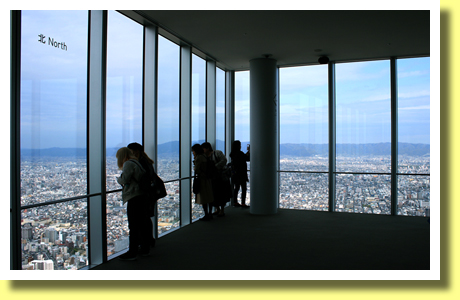
Abeno Harukas, as tall as 300 meters, is the tallest skyscraper in Japan, located in the south of Osaka City. Its top floors are occupied by the viewing platform "Harukas 300" where tourists could enjoy overlooking Osaka as above.
|
|
Shitenno-ji Temple

Shitenno-ji Temple, located near Abeno Harukas, was founded in A.D.593. Though the buildings of the temple have been destroyed and burnt down repeatedly in the fires of war and in disasters, they were reconstructed with reinforced concrete but in the architectural style of its foundation.
Tourists could enter and walk up the five-storey pagoda ( above left ) as well as they could enter Kondo ( the main hall - above right ), which was built to enshrine Shotoku Taishi ( Prince Shotoku ) who founded the temple as one of the oldest temples in Japan. The temple holds dozens of designated National Treasures of Japan and National Important Cultural Properties of Japan.
|
|
Sumiyoshi-taisha Shrine
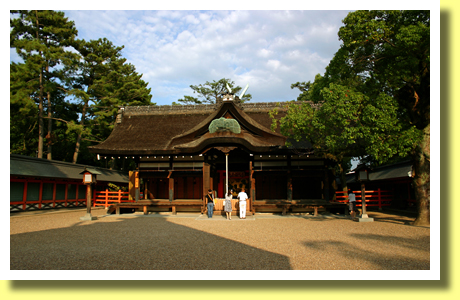
It is said that Sumiyoshi-taisha ( shrine ) was founded in the 3rd century to enshrine the gods of the sea. So Sumiyoshi-taisha is one of the oldest shrines in Japan. Four main halls of the shrine ( above photo shows 1st main hall ), built in A.D.1810, are designated National Treasures of Japan while in the shrine there are dozens of designated National Important Cultural Properties of Japan including buildings, swords, masks and so on.
In almost two thousand years since Sumiyoshi-taisha was founded, more than two thousand smaller Sumiyoshi shrines were founded all over the country. People visit Sumiyoshi shrines and pray the gods of sea to protect seamen, fishermen and travellers on the sea.
|
|
Tsuten-kaku and Shin-sekai
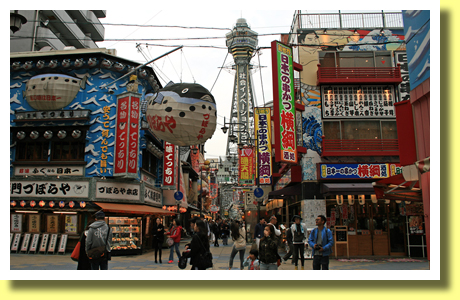
"Tsuten-kaku" tower ( above ) is located in the south of Osaka City. Tsuten-kaku tower, only 108 meters in height, is much shorter than Abeno Harukas. However the tower and the surrounding area "Shin-sekai" are so popular among tourists.
Tsuten-kaku tower was built in A.D.1912 after the Eiffel Tower in Paris. The tower was damaged by a fire and scrapped in A.D.1943. The current tower was constructed in A.D.1956. The 5th floor of the tower is occupied by the viewing platform where tourists could overlook Shin-sekai and look up at the skyscraper Abeno Harukas.
|
|
Janjan Yokocho Alley
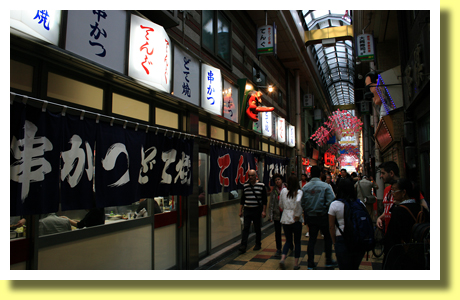
There are dozens of small and cheap restaurants and izakaya ( Japanese-style pubs ) along Janjan Yokocho Alley ( above ), which is located in Shin-sekai near Tsuten-kaku tower. Janjan Yokocho is one of my most favourite alleys in Japan.
|
|
Eating and Drinking
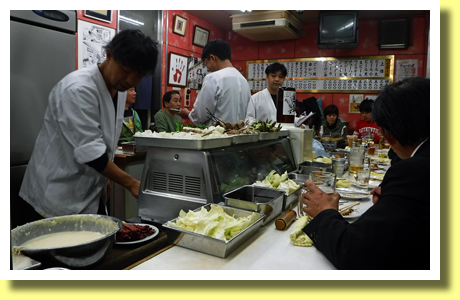
So many people, inhabitants and tourists, visit Janjan Yokocho and enjoy eating various Osaka dishes and drinking beer, sake and shochu in various restaurants and izakaya.
|
|
Kushi-katsu
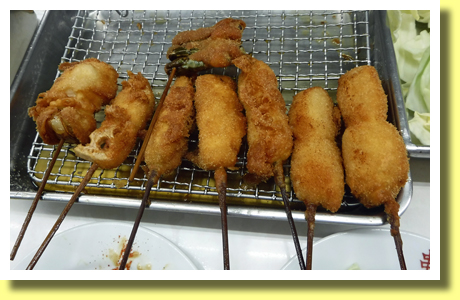
My most favourite dishes, offered in Janjan Yokocho, is Kushi-katsu ( above ). Kushi-katsu is deep-fried skewered foods such as beef, pork, chiken, prawn, squid, octpus, shiitake muchroom, onion, pumpkin, ginger and so on. Kushi-katsu is one of the most famous specialties in Shin-sekai, though there are many restaurants serving Kushi-katsu throughout Osaka.
|
Copyright (c) 2021 Achi-Kochi Zanmai Co., Ltd.
|